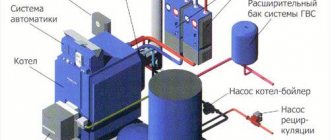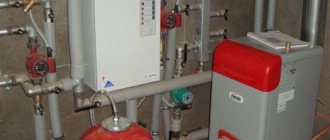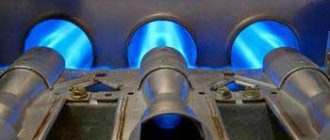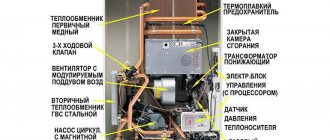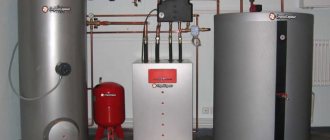Today, many people prefer to eat vegetables and fruits grown in their own garden plot. Everyone wants to see fresh food on their table all year round. For some, it is proper nutrition, and for others, it is a way to earn money.
To achieve the possibility of growing various crops at any time of the year, regardless of weather conditions, it is necessary to properly equip the heating system in the greenhouse.
You can entrust the installation of the greenhouse heating system to professionals, but if you have the desire and some knowledge, it is better to do it yourself.
Types of heating
You can heat a greenhouse in various ways and each of them has its pros and cons.
To learn about the applications and types of induction heating boilers, click here.
You can read about the design, principle of operation and leading manufacturers of double-circuit electric boilers at the link -
Also read about the types and features of operation of solid fuel and liquid fuel boilers.
Air heating
The simplest and cheapest type of air heating has the following structure: a three-meter steel pipe is brought into the greenhouse at one end, while a fire is lit under the other. As soon as the pipe begins to heat up, hot air enters the greenhouse, thereby heating it.
This type of air heating is not particularly convenient due to the need to constantly keep the fire burning, so it is used only in emergency cases. If instead of a fire there is a modern heating boiler, then the process of heating the greenhouse will become much easier.
With the help of a boiler, the greenhouse heats up quickly and efficiently, but there is also a disadvantage - drying out the air in the heated room.
The air in the boiler washes the firebox and heats up, after which it is distributed throughout the greenhouse using air ducts. The lack of humidity can be compensated for by placing buckets of water inside the greenhouse or using modern air humidifiers.
The combustion products of a heating boiler have a high temperature, which can be used to heat the soil (through pipes).
Water heating
Heating greenhouses using liquid coolant is the most common. The main elements of such a heating system are: a boiler, heating circuits (radiators, coils), a circulation pump, pipelines, fittings and protective elements.
To uniformly heat the greenhouse, it is necessary to install several heating circuits at different height levels and an underground “warm floor” coil. Regulating the air temperature in the greenhouse can be entrusted to automatic sensor-relays. The temperature will be regulated by decreasing or increasing the intensity of coolant movement.
If you install your own circulation pump and temperature relay for each heating circuit, you can set an individual operating mode for each circuit.
If we compare water and air heating systems, then:
- An air heating system warms up a room faster than water heating.
- Air heating has a simple design and does not require a lot of additional equipment, unlike water heating.
- Water heating has a labor-intensive installation process and requires the installation of additional equipment, but is more efficient than air heating.
Boiler selection
The choice of boiler for heating a greenhouse directly depends on the preferred type of fuel, the size of the greenhouse and the outside air.
Depending on the type of fuel, the units are:
- Solid fuels burn coal, peat, and firewood. They come in regular, long-burning and gas-generating types.
- Liquid fuel boilers burn diesel fuel or kerosene.
- Combination boilers can operate on different types of fuel.
- Gas boilers operate on natural gas or a propane-butane mixture.
- Electric boilers do not burn fuel. The coolant is heated using heating elements.
The power of the unit is selected in accordance with the calculation of heat losses of the greenhouse and its dimensions.
Wood-fired air-heating boilers
Air heating units that burn wood can quickly heat the air in a greenhouse, while installing the boiler is not a labor-intensive process.
The operating principle of an air-heating boiler is based on creating natural air circulation in the greenhouse: the air heated in the boiler is sent into the greenhouse, thereby displacing cold air back into the boiler and this cycle is constantly repeated.
Air-heating pyrolysis (gas generator) boilers are a regular solid fuel boiler, but with an additional firebox. It is needed to burn flammable gas, which is released when burning wood with oxygen deficiency.
The furnaces of the pyrolysis boiler are located one above the other. Firewood is loaded into the lower one and ignition is carried out. During the combustion process, pyrolysis gas is released, which accumulates in the upper firebox and ignites there, releasing heat.
Advantages of pyrolysis boilers:
- High coefficient of efficiency (efficiency).
- Relatively cheap compared to analogues.
- Easy to install.
- Quick heating of the room.
- Long service life (from 20 years).
Solid fuel boilers
Today, wood heating units are the most common and affordable. This is due to their high productivity and efficiency, because the fuel for them is ordinary firewood, waste from furniture and woodworking industries, wood trimmings, branches cut from trees and even dry garbage.
You can choose among the following types of solid fuel boilers:
- wood (conventional or pyrolysis);
- coal and wood;
- pellet (work on compressed pellets of wood, seeds, straw, and various waste).
Solid fuel boilers for greenhouses have many advantages:
- environmental friendliness;
- cheapness;
- availability;
- safety;
- aesthetics;
- non-explosive.
The efficiency of such boilers is in the range of 75–90%.
Using solid fuel boilers as a method of heating the greenhouse, you can be content with fresh vegetables and fruits all year round.
However, such devices also have some disadvantages:
- To store such devices, you need a “solid” size area.
- It is necessary to prepare fuel in advance.
- They require regular maintenance (cleaning the boiler firebox from ash, adding fuel).
How to make a boiler for a greenhouse with your own hands
If you want to save money and do not want to buy a ready-made unit, you can make a solid fuel boiler for heating a greenhouse with your own hands.
To do this you need to perform a number of actions:
- Get a barrel with a volume of 3 cubic meters.
- Using a drill, drill three holes in it, which will serve for the outlet of the chimney, drain and expansion tank.
- At the next stage, a 5 m high chimney is attached to the barrel. This device will be responsible for removing carbon dioxide from the greenhouse.
- An expansion tank must be attached to the top of the barrel; you can weld it yourself.
- Then you need to lay a heating system throughout the greenhouse; the best and cheapest way is plastic pipes.
- Using a special soldering iron, you need to weld the pipes together.
What are the benefits of solid fuel boilers for greenhouses?
If we are not talking about the need for long-term (year-round) use, it is better to opt for solid fuel systems. The list of such systems opens with a model running on coal. If we talk about its advantages, then attention should be focused on the opportunity to save a lot of money. Unlike a water or electric heating system, a coal heating system does not require the installation of expensive infrastructure.
In addition, there is no need to contact factory representatives for expensive spare parts. On the market you can find homemade coal boiler houses, the cost of which is low.
A solid fuel boiler is a good incentive to save money on heating. You can learn more about the solid fuel boiler in the article: https://homeli.ru/stroitelstvo-doma/inzhenernye-sistemy/otoplenie/kotly-na-tverdom-toplive
If you look at the All-Russian Product Classifier (OKP), you can find a little more useful information in it:
- Heating product code - 1500;
- It is recommended to purchase a sufficient amount of cleaner, because burning coal is always accompanied by the release of a large amount of soot;
- The use of wood pits helps to get rid of such problems, but they are permissible only in small greenhouses;
- The presence of a built-in temperature sensor allows you to monitor and regulate the combustion temperature in real time;
- The opportunity to quickly purchase fuel exists in any locality; for example, in Kotlas they always sell coal in bags or by weight.
Gas devices
Gas boilers for greenhouses are a good option. They ensure that the greenhouse operates smoothly and is heated at a level suitable for the vegetation. The automation of the boiler ensures its autonomous operation, while human participation in this case is limited.
Using gas heating, you can heat the greenhouse in one of the following ways: air, water, infrared.
Infrared gas heater for greenhouse
Most often, infrared gas heaters are installed on the roof. This is due to the fact that gas infrared heating of a greenhouse in winter has one important advantage: the soil is heated first, and only after it the air.
The disadvantage of such heating is the need to install ventilation to remove combustion products.
The second option is to heat the greenhouse with a gas boiler combined with a water system.
Gas boiler for greenhouse
To put this heating method into effect, it is necessary to install smooth pipes with a diameter of no more than 40 mm over the entire area. They need to be laid along each bed 20-30 cm above ground level. The following types of wiring are allowed:
- The supply line is along one wall, the return line is near the other. They are connected to each other by transverse pipes running between the beds.
- The supply and return lines are laid along one wall. Each heating pipe runs along one bed and returns past another.
- The pipe is laid in a snake pattern over the entire area of the greenhouse, forming a single heating circuit.
Shut-off valves must be installed on each branch so that it is possible to turn off the circuit in the event that there is no vegetation in the greenhouse.
In a greenhouse heating system using a gas boiler, the main advantages can be noted:
- autonomous operation of the device;
- ease and speed of boiler maintenance;
- high efficiency.
- It is difficult to supply gas to the greenhouse: you need to call a special service.
- High cost of gas tariffs, especially in the summer.
Electric boilers
Electric boilers are easy to use and accessible wherever power lines are installed. But if you want to purchase an electric boiler to heat the greenhouse, then you should understand that such equipment is quite expensive, and its use is not always appropriate or justified. In addition, now there are often blackouts, and during such a period your vegetation may simply die.
However, such heating, calculated per unit of heat, is the most expensive. In addition, to connect an electric boiler, a separate line is required, and often not 220 V, but 380 V, and wiring such a line is a complex, time-consuming and expensive process, and besides, this option is not possible everywhere due to the lack of technical capabilities.
The advantages and disadvantages of an electric boiler for greenhouses are as follows.
| Advantages | Flaws |
| Low price of equipment. | The need for a permanent connection to the power grid. |
| Availability. Can be purchased at any large hardware store. | High energy costs. On average, electricity bills when using such a heat source increase by 10-20%. |
| Convenient control system, so there are no difficulties with operation. | |
| No combustion products, no need to install a chimney. | |
| Minimal maintenance. The electric heating element does not need to be cleaned of soot or dirt, as, for example, in solid fuel boilers. Maintenance is required approximately every 2-3 years. | |
| Convenient to locate, do not take up much space, most devices are wall mounted. |
A greenhouse is a great opportunity to please yourself and your loved ones with fresh and natural vegetables and herbs not only in the summer, but also in the winter. In order to successfully grow vegetable crops and ultimately harvest a good harvest, you need to ensure a good temperature in the greenhouse. Helpers in this matter are boilers for heating greenhouses. Each heating method has pros and cons, so in each individual case one or another option may be the most optimal.
Based on your capabilities, you can choose the appropriate option and ensure the fruitful growth of your plants.
To heat greenhouses, different types of heating are used: from stoves to modern gas boilers. Constant heat ensures a normal microclimate inside the greenhouse.
Thanks to this, the harvest is higher, and it becomes possible to harvest it not once, but two or three times a year.
Do-it-yourself greenhouse heating, winter project, diagram, video
A greenhouse allows you to get a harvest when other gardeners are still watering or planting their plants.
The greenhouse allows you to grow early products by heating the greenhouse yourself, since the sun's heat allows the crop to grow only in the summer. Thanks to this design, fresh products can be grown even in winter.
The minimum permissible temperature in the greenhouse should be +18 degrees. However, in order to achieve such conditions, impenetrable walls alone will not be enough.
Heated greenhouse in winter
The most economical option would be to install a greenhouse in the place where the thermal route runs.
In such a situation, you only need to find the most favorable location and you can begin building the greenhouse.
In other situations, the construction of a greenhouse will be a more complex process, but it can also be done with your own hands - just like heating a greenhouse with your own hands.
READ ALSO: Popular varieties of columnar apple trees
Heating a greenhouse using solar rays
You can also heat a greenhouse structure and make homemade heating in a greenhouse using the sun's rays. The first stage of constructing a greenhouse will be digging a hole about 15 cm deep.
Next, the ground must be covered with a layer of polystyrene or other heat insulator. The whole thing is covered with a layer of plastic film on top to provide waterproofing. Wet sand is placed on the film and covered with earth.
This type of device, although quite simple, can nevertheless maintain the optimal temperature in the greenhouse.
You can do simple air heating of greenhouses in a greenhouse with your own hands. The simplest method for heating a greenhouse is air heating - a good solution to the question of how to make heating in a greenhouse, which is described below:
- You need to take a piece of steel pipe with a length of 2 to 2.5 m and a diameter of 50 to 60 cm.
- You need to light a fire under one end of the pipe, and insert the other end into a greenhouse covered with film.
- The fire must be maintained at all times. The air in the tube will heat up quite quickly, and the plants will receive the warmth they need.
- In the greenhouse vestibule, a furnace firebox made of brick is laid out.
- A chimney is laid along the entire length of the greenhouse.
- The chimney is removed from the greenhouse on the other side so that the carbon monoxide evaporates and the heat remains inside. The distance between the firebox of the greenhouse and its end side should be no less than 25 cm. The distance from the bed with plants to the top of the hog should be no less than 15 cm.
- We find a large barrel, with a volume of at least 3 cubic meters. We paint the inside of the barrel in 2 layers to prevent the rusting process.
- Holes are made in the inside of the barrel, one of which is intended for the chimney, and the others for the expansion tank and for the tap.
- We cook the stove and insert it into the barrel.
- The chimney is removed from the barrel, and a pipe about 5 meters long is installed from the outside.
- An expansion tank with a volume of 20 liters is mounted on the barrel, which must first be welded from ordinary sheet iron.
- The heating itself is made from a profile pipe, which measures 40x20x1.5 cm. The pipes must be laid out on the ground so that they are located at a distance of 1.2 meters. This arrangement of pipes will allow the soil to warm up in those places where plant roots are located.
- In order to ensure water circulation, for such homemade systems it is necessary to purchase a special pump.
- You need to take the body of the old fire extinguisher and cut off the top.
- A heating element with an operating power of 1 kW is installed at the bottom of the fire extinguisher. This heating element can also be taken from an old samovar.
- We make a removable lid on top of the device so that water can be poured into the heater.
- We attach two tubes connected to the radiator to the device body. We secure the tubes using nuts and sealing gaskets. In order for such a heater to operate in automatic mode, you can use a circuit with an alternating current and voltage relay of 220V.
Scheme of simple heating in a greenhouse
Heating a greenhouse with gas
The main advantage of gas is that in terms of supply it is much more stable and accessible than the fire of a fire. In order to heat a greenhouse in winter, there is no need to pipe gas from the house to the greenhouse, since this is not entirely practical.
Also, such a greenhouse heating scheme will require some costs. It is best to purchase several gas cylinders, which should be quite enough.
However, it is worth paying attention to the fact that too much carbon dioxide can cause plants to not grow as they should.
Gas heating scheme
Poor greenhouse ventilation can also affect negative plant growth. It will also be necessary to install a means for exhausting combustion waste in the greenhouse.
They are necessary so that if combustion stops and gas is released into the air, such devices will immediately operate and shut off the gas supply to the burner.
Heating a greenhouse using a solid fuel boiler
This kind of heated greenhouse projects can be located both inside the greenhouse itself and outside it in any other room.
The second option has some advantages, since in order to add fuel or firewood to the fire, there will be no need to go to the greenhouse.
The disadvantage of this option is that if the boiler were located directly in the greenhouse, it would also generate some heat.
The heat generator needs to add fuel only twice a day. In addition, from the point of view of fire safety, such a winter greenhouse with your own hands does not pose a threat. Thanks to this parameter, you can safely leave it unattended all night. Another advantage of the boiler is that it requires minimal fuel consumption.
Stove heating of a greenhouse
Do-it-yourself stove heating of a greenhouse, compared to electric heating, does not burden financial costs as much. A simple stove for a greenhouse can be easily built with your own hands, without actually spending any money.
The principle of constructing a stove for a greenhouse:
Heating a greenhouse using a stove
Before you build a heated greenhouse with your own hands, you can explore another method:
Converted barrel for a stove for a greenhouse
Water heating of a greenhouse
If we take the calculation of heating a greenhouse, then in comparison with other types, the most profitable will be the arrangement of water heating for a greenhouse. Do-it-yourself water heating of a greenhouse - an electric water heater can be made simply:
A register made of pipes with water and an electric heating element inside
When arranging a heating system for a greenhouse or greenhouse, the most important thing is to follow all the necessary instructions, as well as safety regulations. You can watch a video on how to arrange heating for a greenhouse with your own hands below.
Rate this publication: Loading...
Greenhouse heating methods
To maintain a temperature inside the greenhouse of at least 25 degrees Celsius, powerful equipment is required.
The peculiarity of its choice is that it requires heating a fairly large area - sometimes up to 1000-5000 square meters. m.
For this use:
- gas boilers;
- solid fuel stoves;
- electric boilers;
- diesel and combined models;
- IR heaters.
Reference. The most inexpensive option in terms of maintenance is gas boilers. By spending money once on the purchase of the device itself, in the future you will have lower utility bills for gas, maintenance and repairs.
